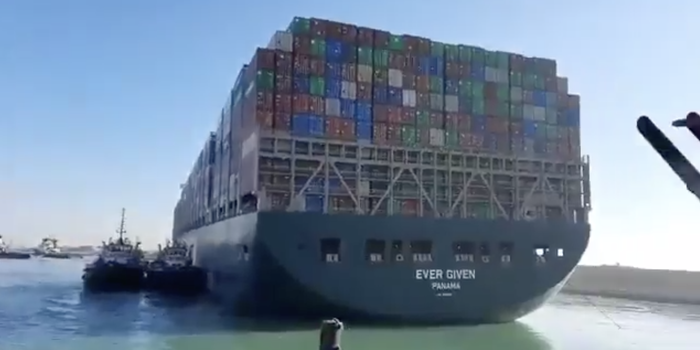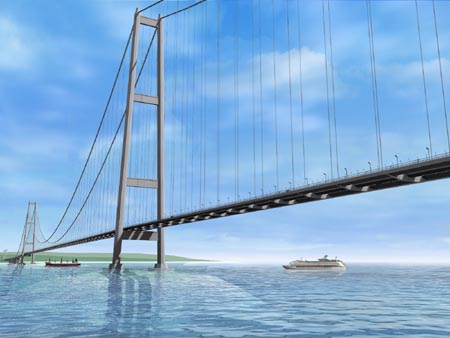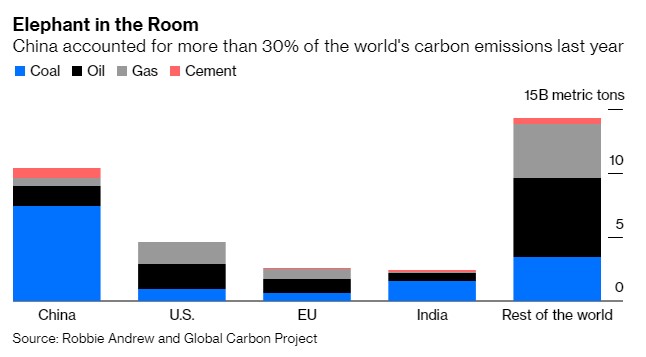
Think the Ever Given was a monster ship? The next generation of container vessels is going to make it look like a bath toy, pushing up against hard limits for the size of boats:
bloomberg.com/opinion/articl…
bloomberg.com/opinion/articl…
Container ships have again and again defied predictions that their size was approaching maximum limits.
One famed 1999 study argued that the biggest possible ships would be able to carry 18,000 containers, or TEUs (20ft-equivalent units). The Ever Given carries 20,124 TEUs.
One famed 1999 study argued that the biggest possible ships would be able to carry 18,000 containers, or TEUs (20ft-equivalent units). The Ever Given carries 20,124 TEUs.

At the time it launched in 2018, only a handful of 20,000+ TEU ships were on the sea, and the first had been launched less than a year ago.
There's now more than 100 of that size sailing or under construction. The biggest ones are 24,000 TEUs, 20% bigger than the Ever Given!
There's now more than 100 of that size sailing or under construction. The biggest ones are 24,000 TEUs, 20% bigger than the Ever Given!

A Chinese shipyard has registered designs for a 25,000 TEU ship which could possibly hold 26,000 containers, and there's predictions that we'll see 30,000 TEU vessels in this decade.
dnv.com/news/dnv-gl-aw…
dnv.com/news/dnv-gl-aw…
As the Suez incident has demonstrated, boats on this scale are starting to push up against hard limits around size.
@bhgreeley argues here that the sheer volume of the Ever Given may have caused it to lose control while traversing the canal:
ft.com/content/171c92…
@bhgreeley argues here that the sheer volume of the Ever Given may have caused it to lose control while traversing the canal:
ft.com/content/171c92…
@bhgreeley But the other issue is around depth and breadth. The biggest ship, the HMM Algeciras, is 61m wide, 400m long, and can extend 16.5m below the waterline:
hhla.de/en/hmm-algecir…
hhla.de/en/hmm-algecir…
@bhgreeley You face various hard limits here. Most ships need 3.5m of clearance from the bottom to be safe from the vagaries of waves and wides, but most major ports have shipping channels no more than 20m deep. They can't accommodate a deeper keel than the Algeciras.
@bhgreeley You can't stack containers any deeper than the 10 to 12 layers that you'll see on the decks of the Ever Given because they're not strong enough to withstand the compressive strength of that many boxes, which means you risk devastating collapses: 

@bhgreeley So boats have to either get longer or wider, but length is limited by the length of existing quays and gantry cranes much more than 60 metres wide start to push up against the limits of weight-bearing steel structures. 

@bhgreeley In theory you could dredge out major ports like Singapore, Rotterdam, and Shanghai to accommodate even deeper draughts, but you also have a problem with channels.
The Suez Canal is 24m deep, and so are the straits of Malacca and Singapore.
The Suez Canal is 24m deep, and so are the straits of Malacca and Singapore.
@bhgreeley While you could probably deepen and dredge Suez as has been done in the past, I suspect Malacca and Singapore will be more challenging. It's a major ocean passage so the seafloor is dynamic.
There's a risk that you dredge away a sandbank only to see tides build it back again.
There's a risk that you dredge away a sandbank only to see tides build it back again.
@bhgreeley That would suggest that we're already at the limit, but I wonder. The economics of bigger ships are incredibly compelling. One 2011 study estimated that costs per container for a 25,000 TEU vessel are about 20% less than for a 12,000 TEU ship:
researchgate.net/publication/26…
researchgate.net/publication/26…
Every time people predict we're about to hit hard limits, someone does the maths on a vessel 5,000 TEU bigger than the current giants and finds that it's still compelling.
If anything this dynamic is going to accelerate as the world decarbonizes.
If anything this dynamic is going to accelerate as the world decarbonizes.
The shipping industry accounts for about 2.2% of global emissions, and because it's hard to decarbonize large boats and trade is always increasing, that share is set to increase sharply. The International Maritime Organization reckons it could reach 15% of emissions by 2050.
One of the simplest ways to reduce this emissions burden is to use bigger ships, which use less fuel per container. Within a decade or so we'll see a lot of boats switch to LNG, which is cheaper and cleaner than diesel, but it also takes up more space in tanks.
Hydrogen would have the same problems, as would batteries -- though it's unlikely using current materials technology that we'll ever see batteries powerful enough to fuel a mega-containership.
My wildest prediction is that we'll at some point see a big jump in size when major shipping lanes become unable to accommodate the next incremental size class and container lines have to switch to alternative routes. 

McKinsey has predicted we may see 50,000 TEU boats in the future. I'm not a naval architect, but it's challenging to see how Suez, Singapore and Malacca could accommodate such a monster vessel.
mckinsey.com/~/media/mckins…
mckinsey.com/~/media/mckins…
One alternative would be to send boats round the Cape of Good Hope rather than Suez and use the deeper channels further south in the Indonesian archipelago: 

That has it's own challenges. The Sunda Strait between Java and Sumatra is the shorter route but it's a very busy channel with ferry traffic between the two populous islands. Arguably, you'd need to first build the abandoned Sunda Bridge megaproject to make it work. 

It's also not *that* much deeper than Malacca and Singapore, and to make things fun it's got an active volcano, Krakatau/Krakatoa (responsible for one of history's biggest eruptions) bang in the middle of it. 

The really bold option would be to move to the Lombok Strait between Lombok and Bali, which is so wide and deep that it doesn't really have size constraints.
But it's so much further than Singapore/Malacca that you'd need much, much bigger ships to defray the bigger daily costs.
But it's so much further than Singapore/Malacca that you'd need much, much bigger ships to defray the bigger daily costs.

Good question from @DPMcBride here. The Northwest Passage through Canada will be challenging for a while and doesn't really help with the key routes here, which are east-west. The Northeast Passage over Siberia is more promising, HOWEVER:
https://twitter.com/DPMcBride/status/1376694083306016768
@DPMcBride While it offers a potentially shorter shipping time in summer than going via Suez and Malacca, the ice-free bits of the Laptev Sea are not deep enough to accommodate the current generation of mega container ships. You'd need to go back to 10,000 TEU boats or smaller.
My really radical notion for the future of shipping is that these future giant ships will be operated not by companies but by governments, and powered not by liquid fuels but by nuclear reactors.
This is what you'd have to do to really seriously decarbonize shipping. Nuclear power is already an extremely established naval technology which is, of course, zero carbon. 

But given the vast proliferation risks (a maritime nuclear power plant is powered by highly-enriched uranium which is pretty much ready for use as bomb material), there's no way this could be in private hands. Ships would need to be heavily armed to prevent nuclear piracy.
There'd also be a problem in that lots of ports won't let nuclear shipping dock. But very few ports would be capable of handling such vast vessels anyway, so that may be less of an issue than it seems. You'd expect less than a dozen ports globally to be big enough.
As for having governments running the world's biggest shipping vessels, that's in a way a return to normal conditions at sea where the public/private demarcation line has been oddly vague since the days of Sir Francis Drake. 

As it is, many of the world's biggest shipping lanes are either government owned or dependent on government financial or regulatory support. The handful that aren't are mostly in Europe, which is the region of the world that's taking decarbonization most seriously.
On balance I think it's probably not going to happen, but don't rule out the prospect that in 2050 we'll see 50,000 TEU nuclear-powered vessels controlled by the French and Chinese governments transiting at a giant logistics hub next to Indonesia's new capital in eastern Borneo. 

Do read the whole piece! bloomberg.com/opinion/articl…
ack, typo. "many of the world's biggest shipping *lines*"
By the way, if you liked this thread, I don't have a Soundcloud but you should check out my earlier thread on the geopolitics of ocean straits:
https://twitter.com/davidfickling/status/1375237787335553024
And this from a few months ago about the role of shipworm in the Industrial Revolution:
https://twitter.com/davidfickling/status/1344404814256504832
Gah, "waves and *tides*"
• • •
Missing some Tweet in this thread? You can try to
force a refresh









